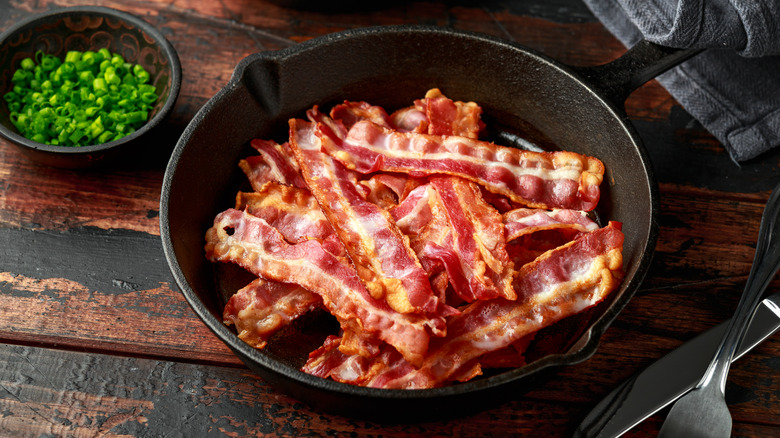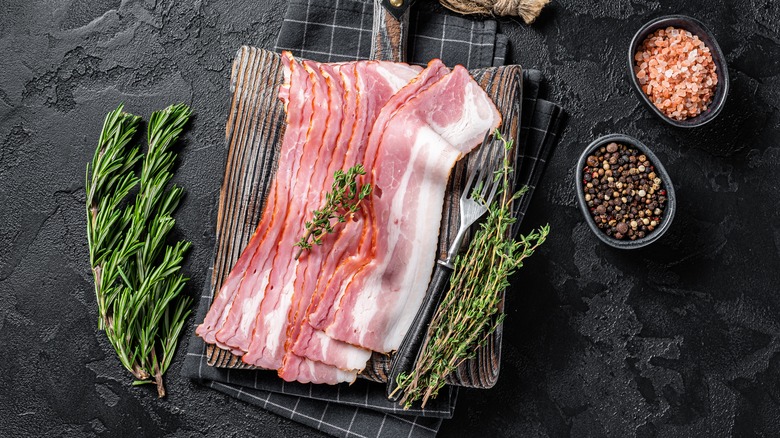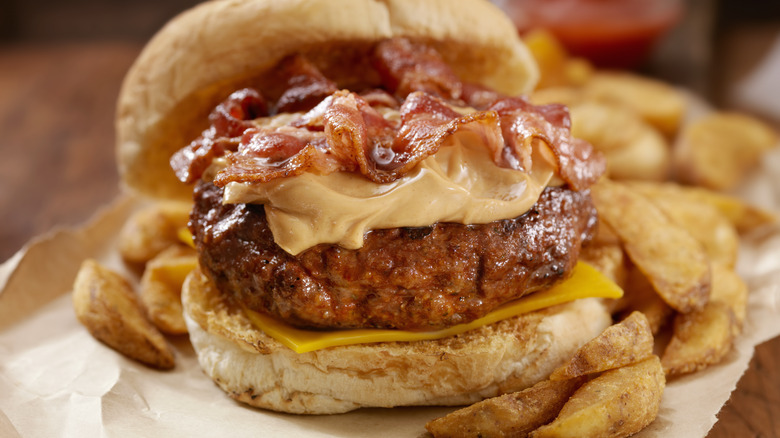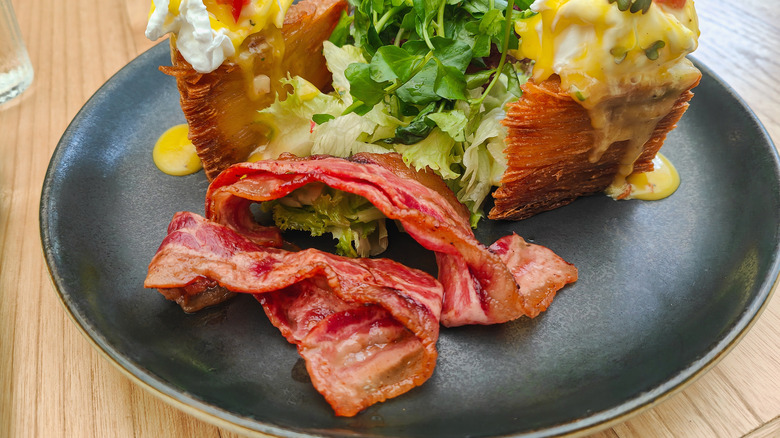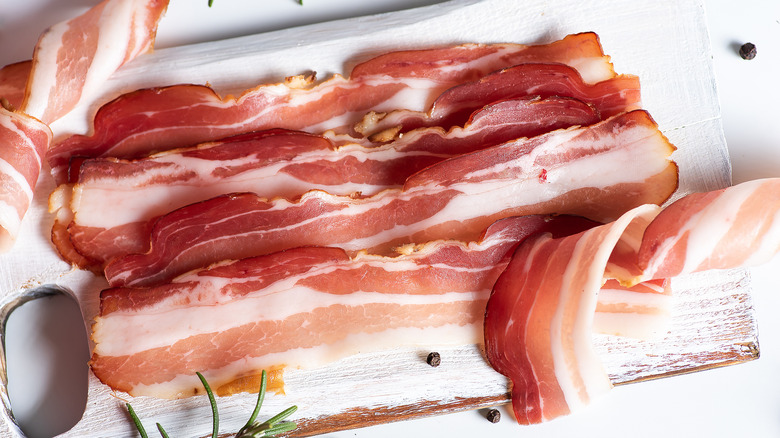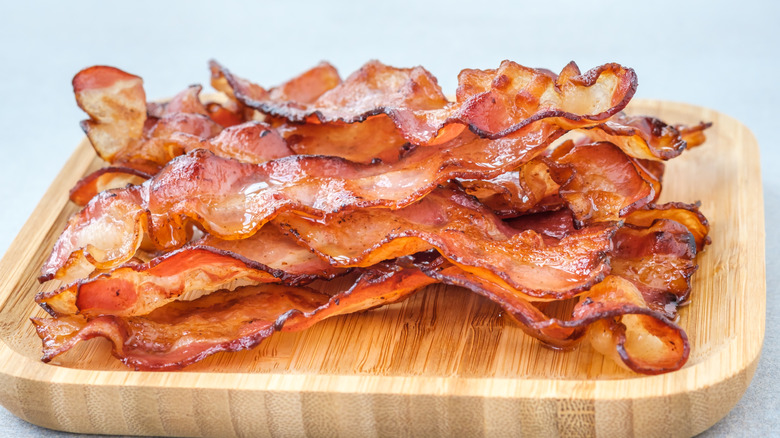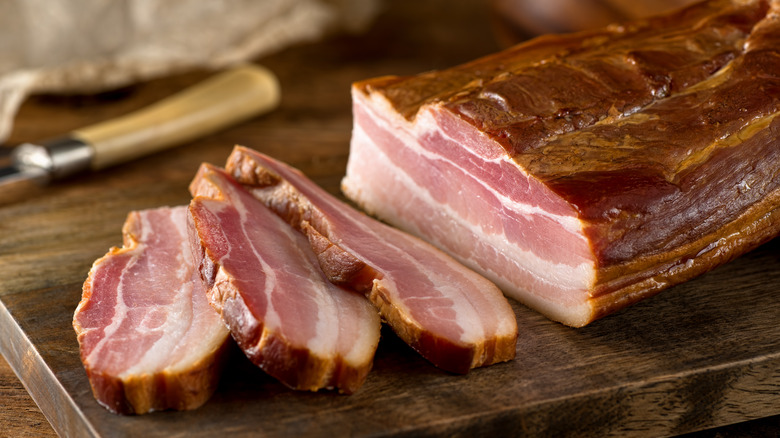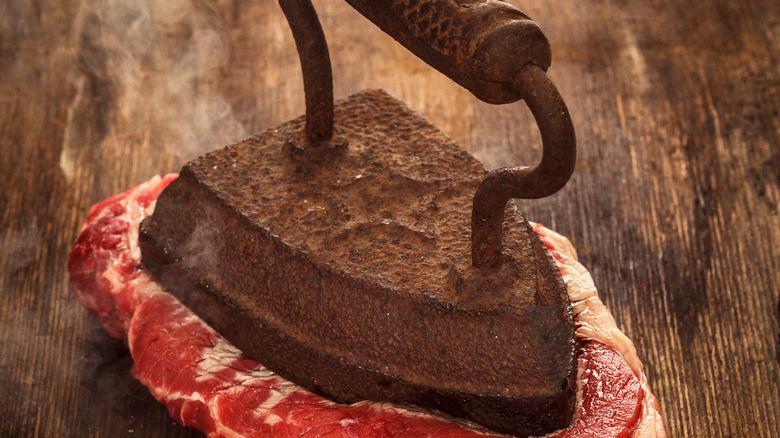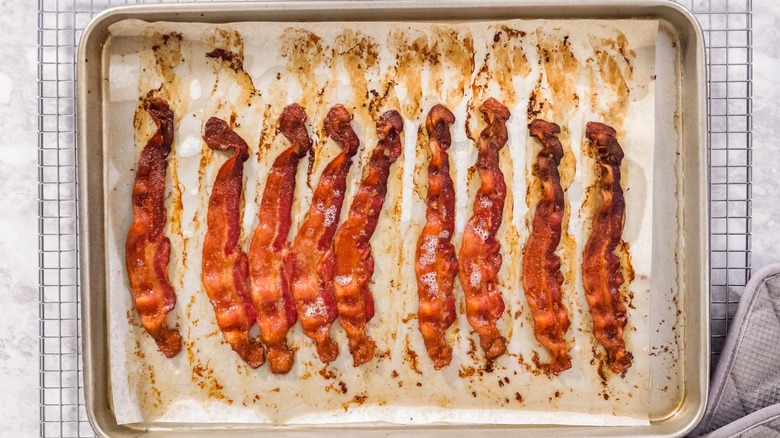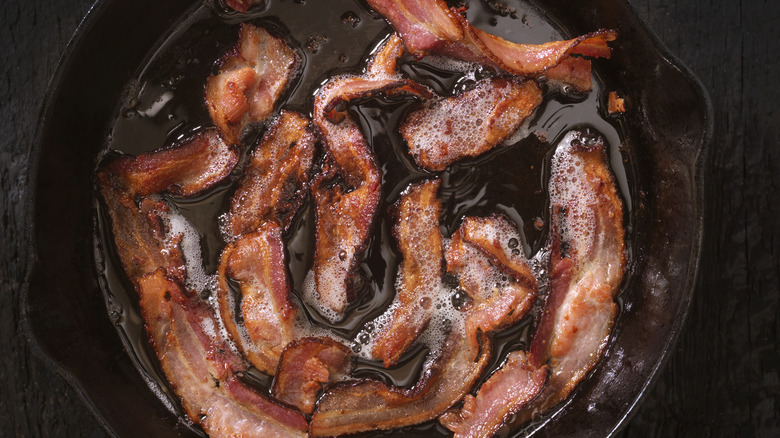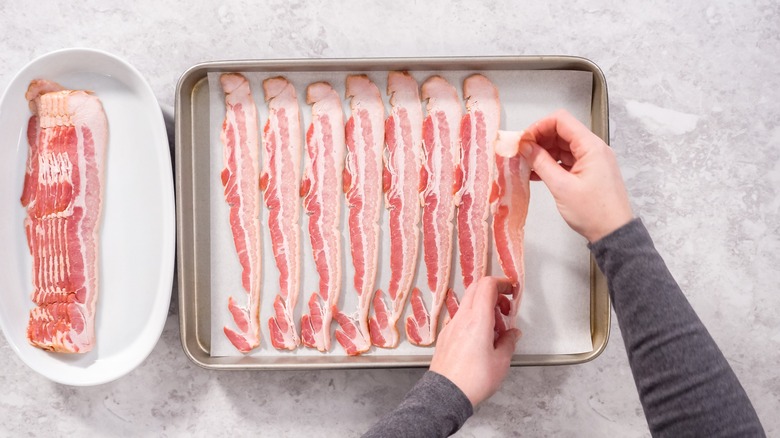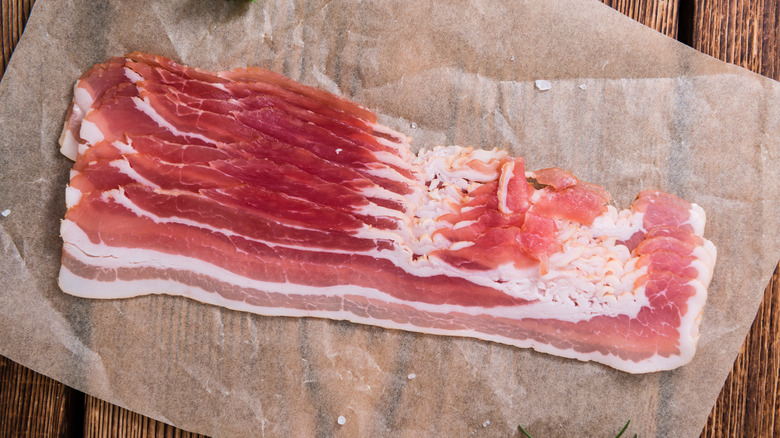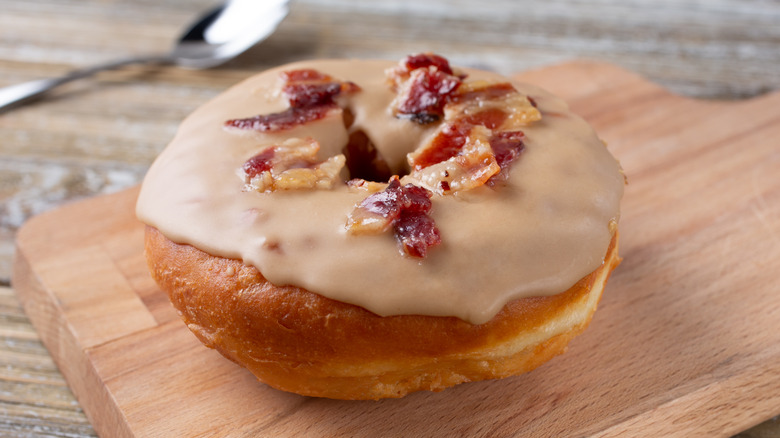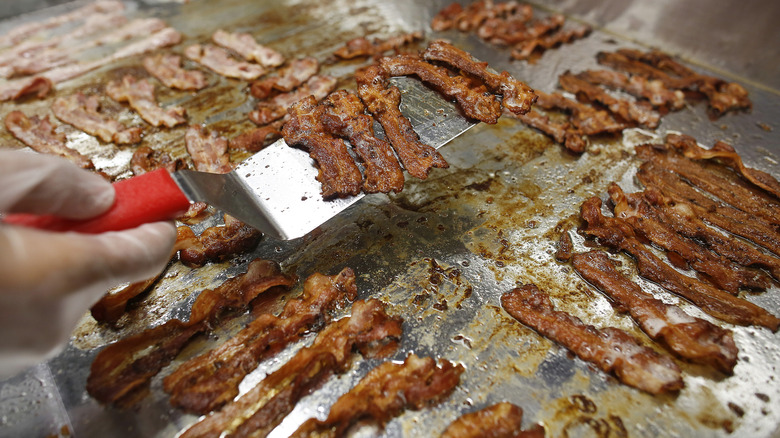13 Reasons Bacon Tastes So Good At Restaurants
No meat has as many devoted fans as bacon does. The pork product is renowned for the passion it inspires in people around the world with its ultra-savory flavor, deep saltiness, and ability to crisp up perfectly. Because it remains so popular among consumers, it's little surprise that restaurants cater to this taste by stocking bacon by the bucketload, in a huge variety of dishes. Approximately 70% of all restaurants in the United States serve bacon in some form, according to the National Pork Board (via Meat + Poultry), and that figure doesn't look like it'll drop anytime soon.
When bacon is so readily available in supermarkets, though, why would we pay for someone to make it for us? Why not save your bacon-eating for home and order something you'd never normally eat in a restaurant instead? Because restaurant bacon is freakin' delicious, that's why. Restaurant chefs have a huge amount of tricks up their sleeves to cook bacon in ways we'd never even think of, as well as access to specific types of bacon that are harder to come across in your local store. In this article we'll blow open some of the tricks of the trade, to reveal exactly why bacon tastes so good in restaurants.
1. It all starts with quality bacon
One of the main reasons that bacon is next-level in restaurants is that your chefs are assessing it with far more scrutiny than you probably are. Chefs are well aware that the quality of their bacon isn't just decided by its price and use-by date. They also take likely animal welfare and diet into account, as well as specifics like how it's been cured and the seasonings that have been used, all of which can have a big impact on its quality.
Chefs don't just look at bacon and decide it's okay, either; they use all their senses. "When you get the package of bacon, you have to smell it. If it smells like bacon — you know what I'm talking about? — but not overly smoky, then you have a good product," Vicky's Diner owner Vasiliki "Vicky" Limberis tells MyRecipes. As Limberis points out, the smell of the bacon has a big impact on its overall flavor. "I've worked some places where you smell the bacon and it smells like nothing. And then when it's cooked, it tastes like nothing, too. So sad." While you can't exactly peel open packages in your supermarket and check their scent, it can be useful to buy your bacon from a butcher. There, you'll be able to check it out a bit more rigorously and ask more questions about where it's from.
2. Restaurants often use a thinner cut
Restaurants can use a variety of bacon cuts, depending on the meal you've ordered. However, they have access to one type of cut that's much harder to find in your local store. "Restaurant bacon" is sliced far thinner than most other types, usually coming in at a 1/32-inch thickness. This is roughly half the thickness of the standard slice you'll find in a supermarket and a quarter of the width of "thick-cut" bacon.
Restaurant bacon is, as you might expect, pretty popular in restaurants, as well as other eateries. There's a good reason why, too. Because the bacon is cut so finely, it cooks way quicker than other styles, allowing restaurants and buffets to serve it up quickly. This speed of cooking and its thinness also means that the slices get far crispier, giving the bacon that glass-shatter effect and stopping it from becoming chewy or flabby on the inside.
The thinness of the bacon also increases its flavor intensity, as you're essentially getting a dose of concentrated flavor in one easy bite. Having said this, restaurants can often also use thicker slices or bacon chunks if the dish calls for it — but if you have a few slices stacked into a towering burger, they're likely a thinner cut.
3. Some diners confit their bacon
Restaurant and diner chefs have a wide variety of cooking methods to extract as much flavor as possible from each slice of bacon. One of these is to add way more cooking oil than you think. Confiting bacon is a trick performed by The Greeks Diner owner John Koutsouris, who completely covers his bacon in oil and then broils it for 20 minutes. Once this is done, the par-cooked bacon is finished on the flat-top grill to each diner's liking.
Confiting bacon has a few key benefits. "The bacon keeps its shape. There's no shrinkage," Koutsouris explains to Epicurious. The flatness of each piece of bacon allows an even distribution of flavor throughout and makes it more aesthetically pleasing. Confiting the bacon also helps to intensify its already intense flavor, making it even more tasty, and stops it from drying out during the cooking process, keeping it juicy by submerging it in the fat. The confiting process also helps it to crisp up nicely on the flat-top grill, as the excess fat renders off each slice. Remember, you don't have to be a trained chef to confit your bacon — you can do it in the comfort of your very own home with a broiler and a deep enough baking sheet.
4. The secret is keeping it fresh
Kitchens are fast-moving places, and stock tends to rotate in and out of them pretty quickly, too. When it comes to your bacon, that's a good thing. The best restaurants try to get through their bacon as quickly as possible, to ensure maximum freshness — and maximum taste. "We don't get our bacon then let it sit in the fridge for even a day. We go through so much that as soon as it's delivered we're cooking and serving it," Vicky's Diner owner Vasiliki Limberis tells MyRecipes. "And that's what you don't get with packaged bacon at home."
Limberis has a point here. When meat is fresh, everything in it is more intact and less prone to deterioration, giving it a more vibrant flavor. With bacon, in particular, it has a better ability to retain its cured flavors. Fresh meat also remains juicier and more moist, as anyone who's ever been able to compare a three-day-old chicken breast to a fresh one can attest to.
Luckily, there are a few ways you can try and get this freshness for yourself at home. Pick the freshest-looking bacon you can find in the store, with the furthest-away use-by date. Or, grab your meat from the deli counter, where it may well have been sliced fresh that day.
5. Lean bacon is key
Bacon is hardly a super-lean meat, and when you buy it in the supermarket, you can often find that half of each slice is devoted to thick, white strips of pure pork fat. The bacon chefs use in restaurants, however, is usually far leaner than the supermarket kind. Chefs often have the benefit of specifying with their suppliers how they like their meat-to-fat ratio, and this gives them less fatty bacon that has the perfect amount of lubrication without getting greasy.
Lean bacon also has the benefit of being more flexible and allows the chef to work it into the shape or dimensions they need, without worrying about it curling up. Because the bacon is more meat-heavy, it also ends up being way more satisfying than slices that are covered in fat. Remember, though, that if you're trying to emulate this at home, buying super-lean or fat-free bacon usually isn't the answer. Much of the flavor in bacon comes from its fat content, and stripping it back too much will reduce its overall flavor. Next time you're working with your slices, though, experiment with trimming a bit more fat off the side than you might normally trim.
6. Some restaurants cure their own bacon
If you've ever wondered why your favorite restaurant's bacon tastes so good, the secret might be that the staff make it themselves. House-cured bacon is the strategy for Core 450's executive chef Todd Warden. As he details to Golf.com, he throws together sweeteners, salt, and black pepper before rubbing his block of pork belly down with the mixture and leaving it to cure for 7 to 10 days. Once the bacon has soaked up all this flavor, Warden then smokes the pork belly, before popping it in the oven until cooked and juicy.
While this might sound like a lot of work, it's worth bearing in mind that the hands-on parts of making your own bacon are relatively short and stress-free — and the result is top-notch. When restaurants cure their bacon, they're able to perfectly control the levels of saltiness and sweetness. They're also able to smoke it to their liking, using their own combination of woods. This all leads to a rich, deep, and specific flavor that doesn't rely on any artificial preservatives to keep it fresh. By making their own bacon, restaurants like Warden's are also able to be super precise about the thickness of their cuts.
7. Chefs often use a grill press
A hallmark of well-cooked bacon is an even brownness and crispiness across each slice. Unless you're standing over your skillet constantly pressing each piece down with your spatula, that can be hard to achieve — particularly because bacon has a knack for curling once it hits the heat, pulling part of the meat away from the hot surface. This is why restaurant chefs often employ a grill press to cook their bacon. Todd Ginsburg, the chef behind the deli concept The General Muir, tells Thrillist that he places these metal presses over each slice of bacon while he's cooking, and doing so develops a consistent color and keeps each piece flat.
Using a grill press is also a fantastic way to reduce bacon splatter. Instead of the fat spitting out toward you, it's blocked by the press and has to escape to either side of the bacon. The flatness you achieve with a grill press isn't just aesthetic, easier. Flatter bacon is way easier to use, both in its whole pieces (slotting easily into sandwiches or burgers, for example) and in chopped form, with the flatness allowing you to slice it more evenly. If you don't have a grill press, you can essentially use anything heavy, flat, and heatproof on your bacon. Just make sure you wrap your object securely in foil first, and don't use anything that you wouldn't want getting a little fatty.
8. Many diners pre-bake their bacon
When you order a bacon dish in a restaurant, it's reasonable to assume that the meat is cooked to order. Luckily, if you're eating in a quality establishment, you're probably right — but it might not be cooked from scratch. Many restaurants partly cook their bacon by pre-baking it in batches, before finishing it off in a skillet or on the flat top. Doing this, Vicky's Diner owner Vasiliki Limberis explains to MyRecipes, is an essential step in draining off some of the excess fat that can ruin each slice. "Otherwise the bacon just sits in its own grease and gets soggy and limp," Limberis states.
After the bacon is baked, establishments like Limberis' then stash it in the fridge, covering each slice in a paper towel so that it doesn't dry out. By finishing off the pre-baked bacon on the stove, diners and restaurants can cook the meat to each diner's specifications, and the super-hot heat gives it a great sear while ensuring it's both cooked through and chewy on the inside. The best part about this method is that you can do it at home, too. Next time you have friends around for brunch, save yourself the hassle of cooking each slice separately from scratch and throw them all in the oven.
9. When restaurants fry their bacon, they follow certain rules
Chefs don't get good overnight, and it's their wealth of professional experience that helps them whip up world-class foods — including bacon. Even for something as simple and commonplace as bacon, chefs tend to follow specific rules and methods that help them generate perfect slices every time. Executive chef Todd Warden, for instance, tells Golf.com that he fries his bacon in a cast iron skillet, which has better heat retention and distribution than other, thinner pans. He also favors using a low-and-slow approach, instead of quick-frying. This slow pace helps the fat render out of the meat, making it juicy and crispy without charring it, and it also stops the kitchen from becoming too smoky or smelly.
Warden also only fries his bacon like this when he's using it in specific dishes, instead of serving it on its own, because a stovetop method can often cause the slices to curl up. When he fries, he slices his bacon into finer pieces before throwing it in the pan. Doing this maximizes the browning you can achieve on each square centimeter of meat and increases its versatility.
10. In restaurants, bacon is often roasted
When it comes to bacon, the stovetop method tends to reign supreme in home kitchens. Restaurant kitchens, however, know the power of using the oven. Most restaurants avoid using the stove entirely and roast their bacon on a sheet pan. Doing this has two main advantages. The first is that roasting bacon is a hands-off method that allows chefs to cook large batches in one go, which they can then use throughout service. The second is that using the oven allows them to cook their bacon in a slower, more controlled manner, reducing the risk of burning the bacon and making sure that each slice is uniform.
Some restaurants are content to simply lay out their bacon on a sheet pan, throw it in the oven, and wait — but if you want to do things like a pro, you'll need to double up. Lay your bacon slices on a parchment-lined pan, cover them with more parchment paper, and place another sheet pan on top, so that it's pushing the bacon slices down. Doing this allows the bacon to cook on both sides, as the heat from each pan warms it up, giving it the maximum amount of color possible. It also helps to compress as much fat as possible out of the bacon, increasing its crispiness.
11. Chefs like to boil their bacon
You might not think that water and bacon go together, but chefs certainly do. Partly cooking your bacon in water is a trick that's favored by restaurants around the world, and it results in ultra-crispy slices every time. To do this, you first place your slices in your skillet as normal and then cover them with water, as demonstrated by chef Roice Bethel on Instagram. You then turn on your heat and slowly simmer the bacon until the water evaporates and the bacon crisps up in its fat.
Doing this, as Bethel explains, harnesses the power of water to help everything cook evenly. Because the meat and fat in bacon cook at different speeds, the water slows everything down and helps achieve uniformity. It's this slow pace that helps the fat render out of the bacon, which is key to getting a super-crispy slice. Cooking bacon in water also prevents any fat splatters from flying all over your kitchen, and as a bonus, your meat will stay flat and long, instead of curling up into shriveled pieces.
12. Restaurants make bacon tastier by using it in clever combos
Restaurant menus aren't made by accident: There's a huge amount of thought that goes into curating each dish, figuring out their order, and deciding what combinations of flavors there are. It's these flavor combos, alongside being cooked to perfection, that often help bacon stand out in eateries. Instead of just serving their bacon with a side of eggs (although there's nothing wrong with that), chefs harness the innate salty-sweet-smoky flavors of the meat to use it as an accent for other ingredients that help create an explosion of flavor. These flavor connections and contrasts help to awaken our taste buds, filling in blind spots in a dish's profile and making everything taste better.
You simply need to look at the menu at Hypnotic Donuts in Dallas, Texas, to see what we mean. The donut joint combines a slice of bacon with a Long John and maple frosting in its "Canadian Healthcare" dish, with the salty bacon helping to highlight the sweetness of the pastry and frosting, and vice versa. Other joints, meanwhile, serve their bacon with a side of blue cheese crumbles, allowing the funk of the cheese to deepen the umami flavors of the meat.
13. A flat-top grill is a chef's best friend
One of the main secrets to cooking brilliant bacon is not so much in the method as it is in the equipment. Restaurant chefs tend to avoid the skillet entirely when frying bacon and instead use a flat-top grill. These large pieces of heated, flat metal allow chefs to cook loads of different slices at once, with the increased space giving them the ability to move slices to a cooler part when they're almost finished. This gives them greater control over the specific crispiness of the bacon.
The larger amount of space that flat-top grills offer also means that it's easier to use objects like grill presses, without worrying about them bashing against the skillet. As many flat-top grills and griddles have built-in grease trays, the fat from the bacon drains away much easier, instead of pooling around the meat, making the bacon extra-crispy. If you don't have a flat-top grill at home (they do take up a lot of space), a good compromise can be buying an electric griddle. These mini-machines allow you to utilize the power of flat-top cooking without having to redesign your whole kitchen.
